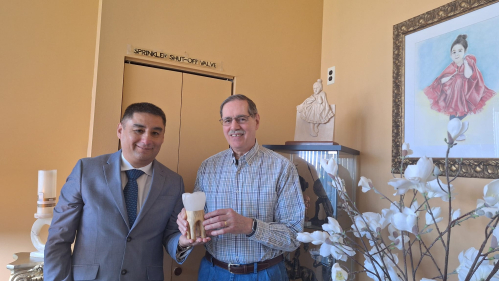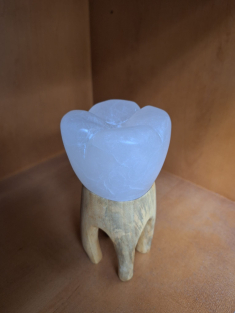Grateful Dental Patient Fashions a Sculpture of Gratitude

George Cooke’s gift of a hand-carved molar to honor his dentist, a Rutgers professor, finds a lasting home at the School of Dental Medicine
George Cooke kept a small piece of translucent white alabaster for years, waiting for the right moment to carve it into something meaningful.
He recently transformed it into a molar tooth sculpture and gifted it to his dentist, Raphael Figueroa -- a present from hands that create to hands that heal.

“It’s a beautiful gift, and nobody will do it just because,” said Figueroa, a clinical associate professor of diagnostic sciences at Rutgers who donated the sculpture to the School of Dental Medicine. “I believe more people should enjoy it. This gift is a blessing, and we have to pass it on.”
Cooke began woodcarving on his own about 30 years ago as a hobby while working in IT data security and disaster recovery. He later took classes at the American Wood Carving School in Wayne, N.J., where he eventually taught courses. He expanded into stone carving after discovering a class in New York more than a decade ago and attended for five years.
His work has been featured in galleries and shows in Pennsylvania and New Jersey. Moreover, he was commissioned to carve a large, 3,000-pound limestone sculpture for McGowan Park Community Pak at his town, Ridgefield Park, N.J.
The idea for the gift came about when Cooke’s wife, Linda, visited Figueroa. The two happen to start talking about Cooke’s work. “She came home and told me about it, and she said, ‘You ought to carve him a tooth,’” Cooke said.
He searched online for molar images.
“We all know basically what a tooth looks like, but when you’re trying to actually carve it, you need a model,” he said.
I looked it up and learned not all teeth have four roots. In fact, that’s fairly rare. But to make it symmetrical and stand, I did the four.
George Cooke
Artist
Using the alabaster that was 3 1/2 inches in diameter and 3 inches high, he first carved it, then wet-sanded it in a tub of water with varying grits of sandpaper until it was smooth, then carved the root from wood.
“I looked it up and learned not all teeth have four roots,” Cooke said. “In fact, that’s fairly rare. But to make it symmetrical and stand, I did the four.”
After about 15 hours of work, the sculpture was complete.
“You carved it with precise anatomy,” Figueroa said as Cooke described his process.
This wasn’t the first artwork Cooke created for Figueroa. Based on a drawing by Figueroa’s former student, Irene Kontogiannis, Cooke spent around three weeks and carved a wooden portrait of the professor’s daughter, Elizabeth Gabriella Figueroa. Cooke completed it at a carving school in Austria, where he sought help with the face – his less familiar specialty – though he had previously carved the faces of his father and three granddaughters.
“When I saw the wood, we loved it,” said Figueroa. “It has a special place in my heart.”
Figueroa keeps that gift right next to Kontogiannis’ painting. As for the sculpture, it will be displayed at the School of Dental Medicine’s Oral Health Pavilion for the community to enjoy.
Cooke was pleasantly surprised upon learning Figueroa was donating the sculpture to the school.
“I’m so excited about it,” said Cooke, a proud Rutgers parent. (His younger daughter graduated from the School of Engineering and his oldest granddaughter earned a political science degree from the School of Arts and Sciences. His other granddaughter is still pursuing her undergraduate studies.)
“I had no idea that he even taught there, much less that they had a place to display things like this,” Cooke said of Figueroa. “I was flattered that he would consider this good enough to be on display at the dental school. I had no idea what effect this gift would have.”


